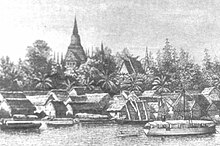-Phnom Phenh City is the capital and most populous city in Cambodia. Phnom Penh has been the national capital since French colonization of Cambodia, and has grown to become the nation's economic, industrial, and cultural center.




Etymology
-Phnom Penh (literally, 'Penh's Hill') takes its name from the present Wat Phnom ('Hill Temple'). Legend has it that in 1372, a wealthy widow named Lady Penh found a Koki tree floating down the Tonle Sap river after a storm.[11] Inside the tree were four bronze Buddha statues and a stone statue of Vishnu. Daun Penh ordered villagers to raise the height of the hill northeast of her house and used the Koki wood to build a temple on the hill to house the four Buddha statues, and a shrine for the Vishnu image slightly lower down. The temple became known as Wat Phnom Daun Penh, which is now known as Wat Phnom, a small hill 27 metres (89 ft) in height.
History
-First recorded a century after it is said to have taken place, the legend of the founding of Phnom Penh tells of a local woman, Penh (commonly referred to as Daun Penh ("Grandmother Penh" or "Old Lady Penh") in Khmer), living at Chaktomuk, the future Phnom Penh. It was the late 14th century, and the Khmer capital was still at Angkor near Siem Reap 350 km (217 mi) to the north. Gathering firewood along the banks of the river, Lady Penh spied a floating koki tree in the river and fished it from the water. Inside the tree she found four Buddha statues and one of Vishnu.
-The Khmer Rouge were driven out of Phnom Penh by the Vietnamese in 1979,[20] and people began to return to the city. Vietnam is historically a state with which Cambodia has had many conflicts, therefore this liberation was and is viewed with mixed emotions by the Cambodians. A period of reconstruction began, spurred by the continuing stability of government, attracting new foreign investment and aid by countries including France, Australia, and Japan. Loans were made from the Asian Development Bank and the World Bank to reinstate a clean water supply, roads and other infrastructure. The 1998 Census put Phnom Penh's population at 862,000;[21] and the 2008 census was 1.3 million.


Geography
-Phnom Penh is in the south-central region of Cambodia, and is fully surrounded by Kandal Province. The municipality is on the banks of the Tonlé Sap, Mekong, and Bassac Rivers. These rivers provide freshwater and other natural resources to the city. Phnom Penh and the surrounding areas consist of a typical flood plain area for Cambodia. Although Phnom Penh is at 11.89 metres (39 ft) above the river, monsoon season flooding is a problem, and the river sometimes overflows its banks.
The city, at 11.55°N 104.91667°E (11°33' North, 104°55' East),[23] covers an area of 678.46 square kilometres (262 sq mi), with some 11,401 hectares (28,172 acres) in the municipality and 26,106 ha (64,509 acres) of roads. The agricultural land in the municipality amounts to 34.685 km2 (13 sq mi) with some 1.476 km2 (365 acres) under irrigation.
Comments
Post a Comment